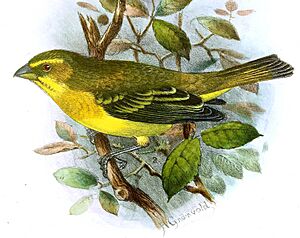Brimstone canary facts for kids
Quick facts for kids Brimstone canary |
|
|---|---|
 |
|
| Conservation status | |
| Scientific classification | |
| Genus: |
Crithagra
|
| Species: |
sulphurata
|
| Synonyms | |
|
|
The brimstone canary or bully canary (Crithagra sulphurata) is a small passerine bird. This means it is a type of perching bird. It belongs to the finch family. You can find these birds living in central and southern Africa.
These canaries like open areas with some trees or bushes. They live on hillsides, at the edges of forests, and in gardens. In South Africa, they often live near the coast. They are not true migratory birds. However, they do move around a bit during different seasons.
Contents
About the Brimstone Canary's Name
Birds get their scientific names from scientists. In 1766, a famous Swedish scientist named Carl Linnaeus gave the brimstone canary its first scientific name. He called it Loxia sulphurata. The word sulphurata is Latin. It means "sulphur-colored," which refers to its yellowish color.
Later, this bird was placed in the genus Serinus. A genus is a group of similar species. But scientists studied the birds' DNA. They found that the Serinus group was too mixed up. So, the brimstone canary and some other birds were moved. They now belong to an older genus called Crithagra. An English bird expert named William Swainson first named this group in 1827.
Different Types of Brimstone Canaries
There are three main types, or subspecies, of the brimstone canary:
- C. s. sulphurata: This type lives in southwestern and southern Cape Province. It is the original type.
- C. s. wilsoni: This type is found from eastern Cape Province to southern Mozambique. It is smaller than the first type. Its bill is also smaller. This type is paler or more yellowish-green. Its belly is completely yellow.
- C. s. sharpii: This type lives from northern Mozambique to Kenya. It is also smaller and paler or more yellowish-green. Its bill size is in between the other two types.
What Does a Brimstone Canary Look Like?
The brimstone canary is about 15–16 centimeters (6 inches) long. It has a strong, thick bill. The bill is light brown with a pink or yellow base. Its legs and feet are pinkish-brown.
Its upper body is yellow-green with dark green stripes. It has yellow-green patches on its face and two yellow stripes on its wings. Its belly is yellow. The sides of its body and chest have a greenish tint.
Boys and girls (males and females) look similar. But the male bird is usually brighter. He has a bigger bill and clearer face markings. His wing stripes are brighter yellow, and his rump (lower back) is greenish. Young birds are duller and grayer than adult birds.
The exact color of these birds can change. Birds in the south are often greener. Birds in the north are more yellow. This can even happen within the same subspecies.
Similar Birds
The brimstone canary can sometimes be mistaken for other canaries. The yellow-fronted canary looks similar. But it has a smaller bill and a much brighter yellow rump. The yellow canary also lives in the same areas. It can also be confused with the brimstone canary.
Their Calls and Songs
Brimstone canaries in the southern parts of their home have a deep, trilling call. It sounds like swirriwirrit or chirrup. Their song is a mix of chirps, whistles, and trills. It has the same deep sound as their call. Birds in the north sing a faster, higher, and more musical song.
Brimstone Canary Behaviour
Breeding and Nests
Brimstone canaries usually breed from August to October. They build a cup-shaped nest. They use thin stems and other plant materials. They line the nest with soft plant fluff. The nest is usually placed in a leafy bush or a tree.
What They Eat
Brimstone canaries are not as social as some other canaries. You will often see them alone or in pairs. Sometimes, you might see them in small groups. They often visit gardens.
They eat different things like fruit, seeds, flowers, and young plant shoots. Their strong bill helps them crack open hard seed cases.



